Indesit IWSC 51051 C ECO EU User Manual

Instructions for use
WASHING MACHINE
|
|
|
|
|
|
|
|
|
|
|
|
|
|
|
Contents |
|
|
|
|
|
|
|
|
GB |
||
|
|
|
|
|
|
|
|
|
|
|
|
|
|
|
Installation, 2-3 |
|
|
|
|
|
|
|
|
|
||
GB |
|
CZ |
|
RO |
|
|
||
|
|
|
Unpacking and levelling |
|
||||
|
|
|
|
|
|
Connecting the electricity and water supplies |
|
|
|
|
|
|
Română, 25 |
|
|||
English,1 |
Česky, 13 |
The first wash cycle |
|
|||||
|
|
|
|
|
|
Technical data |
|
|
DE SK
Deutsch, 37 |
Slovensky, 49 |
IWSC 51051
Description of the washing machine and starting a wash cycle, 4-5
Control panel Indicator lights Starting a wash cycle
Wash cycles, 6
Table of wash cycles
Personalisation, 7
Setting the temperature
Setting the spin speed
Functions
Detergents and laundry, 8
Detergent dispenser drawer
Bleach cycle
Preparing the laundry
Garments requiring special care
Load balancing system
Precautions and tips, 9
General safety
Disposal
Care and maintenance, 10
Cutting off the water or electricity supply Cleaning the washing machine Cleaning the detergent dispenser drawer
Caring for the door and drum of your appliance Cleaning the pump
Checking the water inlet hose
Troubleshooting, 11
Service, 12
1
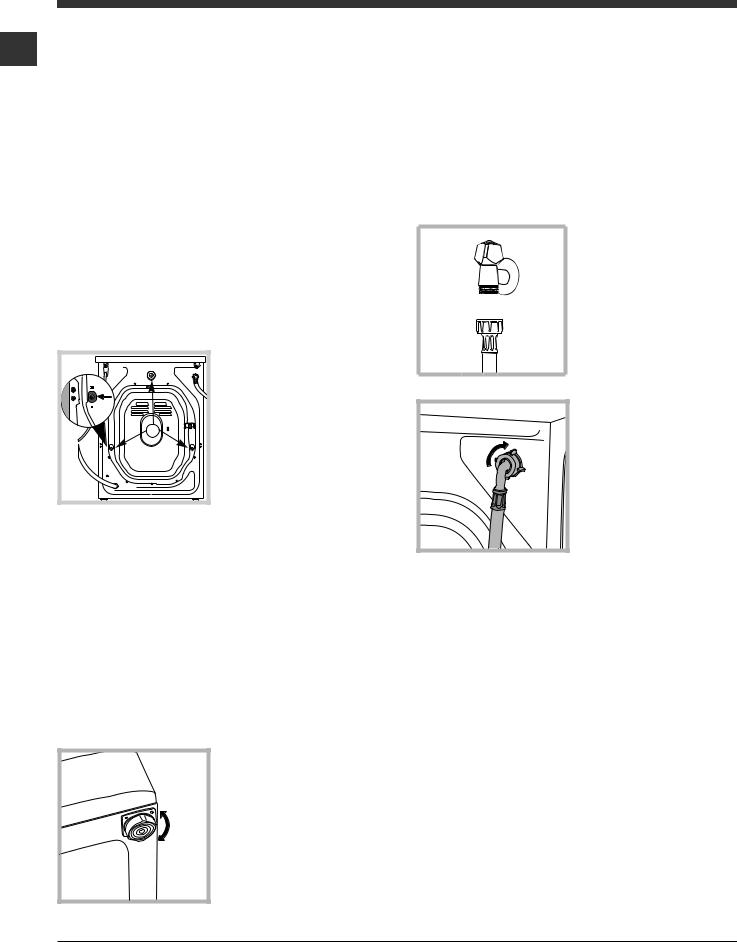
Installation
! This instruction manual should be kept in a safe place for GB future reference. If the washing machine is sold, transferred
or moved, make sure that the instruction manual remains with the machine so that the new owner is able to familiarise himself/herself with its operation and features.
! Read these instructions carefully: they contain vital information relating to the safe installation and operation of the appliance.
Unpacking and levelling
Unpacking
1.Remove the washing machine from its packaging.
2.Make sure that the washing machine has not been damaged during the transportation process. If it has been damaged, contact the retailer and do not proceed any further with the installation process.
3. Remove the 3 protective screws (used during transportation) and the rubber washer with the corresponding spacer, located on the rear part of the appliance (see figure).
4.Close off the holes using the plastic plugs provided.
5.Keep all the parts in a safe place: you will need them again if the washing machine needs to be moved to another location.
! Packaging materials should not be used as toys for children.
Levelling
1. Install the washing machine on a flat sturdy floor, without resting it up against walls, furniture cabinets or anything else.
2. If the floor is not perfectly level, compensate for any unevenness by tightening or loosening the adjustable front feet (see figure); the angle of inclination, measured in relation to the worktop, must not exceed 2°.
Levelling the machine correctly will provide it with stability, help to avoid vibrations and excessive noise and prevent it from shifting while it is operating. If it is placed on carpet or a rug, adjust the feet in such a way as to allow a sufficient ventilation space underneath the washing machine.
Connecting the electricity and water supplies
Connecting the water inlet hose
1. Connect the supply pipe by screwing it to a cold water tap using a ¾ gas threaded connection (see figure).
Before performing the connection, allow the water to run freely until it is perfectly clear.
2. Connect the inlet hose to the washing machine by screwing it onto the corresponding water inlet of the appliance, which is situated on the top right-hand side of the rear part of the appliance (see figure).
3. Make sure that the hose is not folded over or bent.
!The water pressure at the tap must fall within the values indicated in the Technical details table (see next page).
!If the inlet hose is not long enough, contact a specialised shop or an authorised technician.
!Never use second-hand hoses.
!Use the ones supplied with the machine.
2

Connecting the drain hose
65 - 100 cm |
Connect the drain hose, without bending it, to a drainage duct or a wall drain located at a height between 65 and 100 cm from the floor;
alternatively, rest it on the side of a washbasin or bathtub, fastening the duct supplied to the tap (see figure). The free end of the hose should not be underwater.
! We advise against the use of hose extensions; if it is absolutely necessary, the extension must have the same diameter as the original hose and must not exceed 150 cm in length.
Electrical connections
Before plugging the appliance into the electricity socket, make sure that:
•the socket is earthed and complies with all applicable laws;
•the socket is able to withstand the maximum power load of the appliance as indicated in the Technical data table
(see opposite);
•the power supply voltage falls within the values indicated in the Technical data table (see opposite);
•the socket is compatible with the plug of the washing machine. If this is not the case, replace the socket or the plug.
!The washing machine must not be installed outdoors, even in covered areas. It is extremely dangerous to leave the appliance exposed to rain, storms and other weather conditions.
!When the washing machine has been installed, the electricity socket must be within easy reach.
! Do not use extension cords or multiple sockets.
GB
!The cable should not be bent or compressed.
!The power supply cable must only be replaced by authorised technicians.
Warning! The company shall not be held responsible in the event that these regulations are not respected.
The first wash cycle
Once the appliance has been installed, and before you use it for the first time, run a wash cycle with detergent and no laundry, using the wash cycle 2.
Technical data
Model |
IWSC 51051 |
|
|
|
|
|
width 59,5 cm |
|
Dimensions |
height 85 cm |
|
|
depth 44 cm |
|
|
|
|
Capacity |
from 1 to 5 kg |
|
|
|
|
Electrical |
please refer to the technical data plate |
|
connections |
fixed to the machine |
|
|
|
|
|
maximum pressure 1 MPa (10 bar) |
|
Water connection |
minimum pressure 0.05 MPa (0.5 bar) |
|
|
drum capacity 40 litres |
|
|
|
|
Spin speed |
up to 1000 rotations per minute |
|
|
|
|
Test wash cycles |
|
|
in accordance |
Programme 2: Cotton standard 60°C; |
|
with directives |
||
Programme 3: Cotton standard 40°C. |
||
1061/2010 and |
||
|
||
1015/2010 |
|
This appliance conforms to the following
EC Directives:
-2004/108/CE (Electromagnetic Compatibility)
-2002/96/EC
- 2006/95/EC Low Voltage)
3
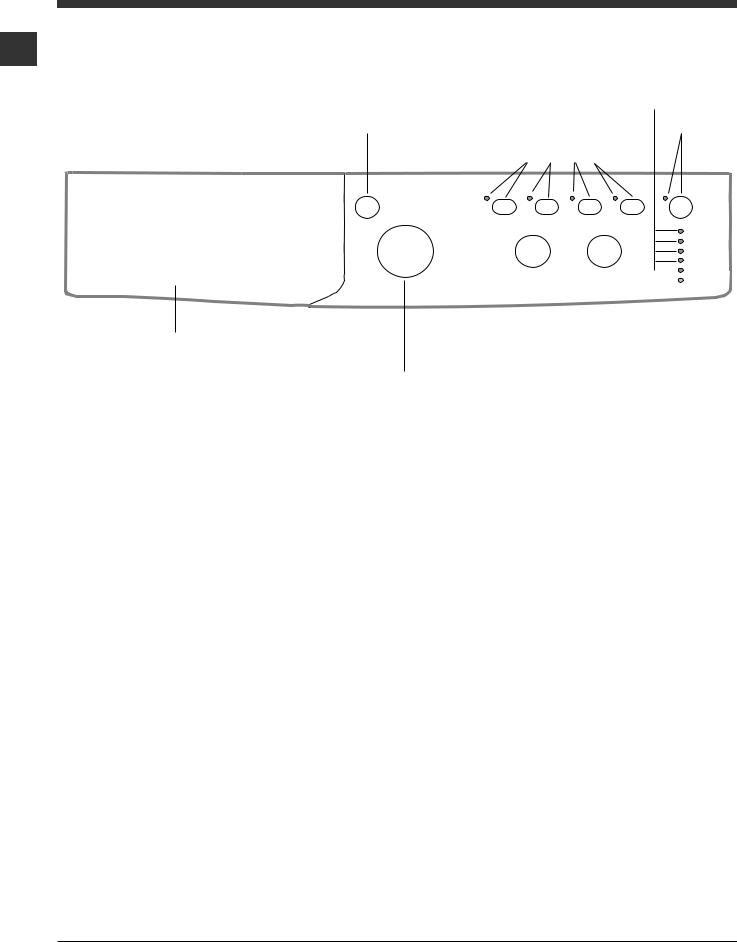
Description of the washing machine and starting a wash cycle
GB |
Control panel |
|
ON/OFF button
Detergent dispenser drawer
WASH CYCLE knob
Detergent dispenser drawer: used to dispense detergents and washing additives (see “Detergents and laundry”).
ON/OFF button: switches the washing machine on and off.
WASH CYCLE knob: programmes the wash cycles. During the wash cycle, the knob does not move.
FUNCTION buttons with indicator light: used to select the available functions. The indicator light corresponding to the selected function will remain lit.
TEMPERATURE knob: sets the temperature or the cold wash cycle (see “Personalisation”).
SPIN SPEED knob: sets the spin speed or exclude the spin cycle completely (see “Personalisation”).
WASH CYCLE PROGRESS/DELAY TIMER indicator lights: used to monitor the progress of the wash cycle. The illuminated indicator light shows which phase is in progress.
If the Delay Timer function has been set, the time remaining until the wash cycle starts will be indicated (see next page).
DOOR LOCKED indicator light: indicates whether the door may be opened or not (see next page).
WASH CYCLE PROGRESS/
DELAY TIMER indicator lights
FUNCTION |
START/ |
|
PAUSE |
||
buttons with |
||
indicator lights |
button with |
|
indicator light |
||
|
TEMPERATURE |
|
|
|
|
|
|
|
|
|
|
|
|
|
|
|
DOOR LOCKED |
||||
knob |
|
|
||||
|
||||||
SPIN SPEED |
indicator light |
|||||
|
|
|
|
|||
|
|
knob |
|
|
|
|
START/PAUSE button with indicator light: starts or temporarily interrupts the wash cycles.
N.B. To pause the wash cycle in progress, press this button; the corresponding indicator light will flash orange, while the indicator light for the current wash cycle phase will remain lit in a fixed manner. If the DOOR LOCKED  indicator light is switched off, the door may be opened.
indicator light is switched off, the door may be opened.
To start the wash cycle from the point at which it was interrupted, press this button again.
Standby mode
This washing machine, in compliance with new energy saving regulations, is fitted with an automatic standby system which is enabled after about 30 minutes if no activity is detected. Press the ON-OFF button briefly and wait for the machine to start up again.
Consumption in off-mode: 1W Consumption in Left-on: 1W
4
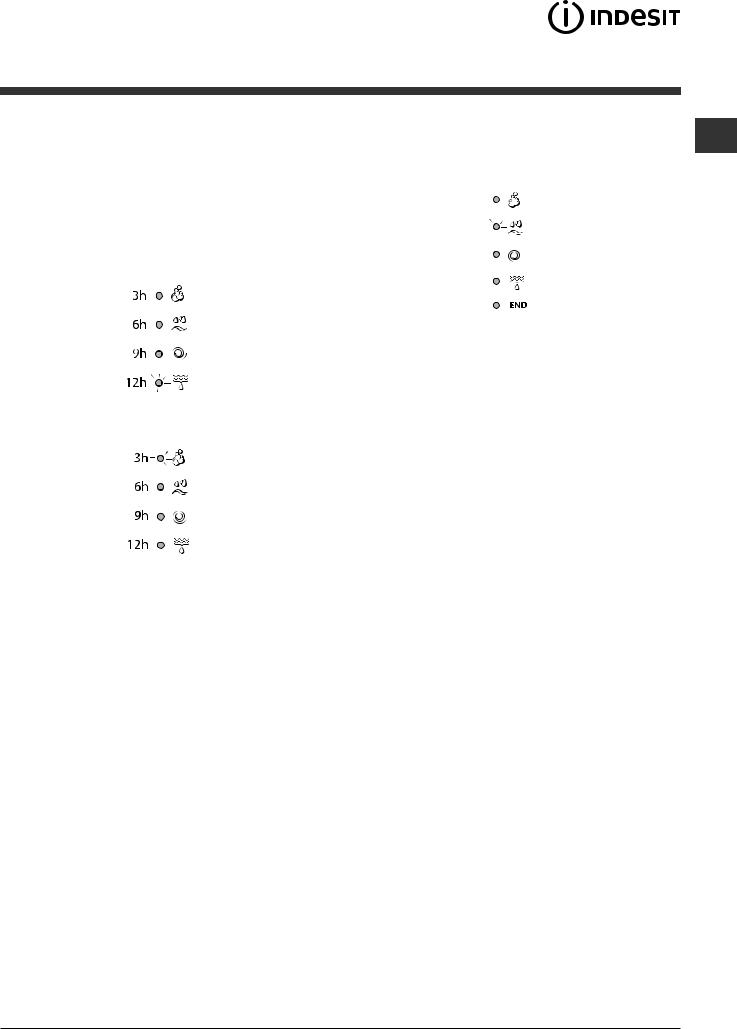
Indicator lights
The indicator lights provide important information. This is what they can tell you:
Delayed start
If the DELAY TIMER function has been activated (see “Personalisation”), after the wash cycle has been started the indicator light corresponding to the selected delay period will begin to flash:
As time passes, the remaining delay will be displayed and the corresponding indicator light will flash:
The set programme will start once the selected time delay has expired.
Wash cycle phase indicator lights
Once the desired wash cycle has been selected and has be- GB gun, the indicator lights switch on one by one to indicate which
phase of the cycle is currently in progress.
Wash
Rinse
Spin
Drain
End of wash cycle
Function buttons and corresponding indicator lights
When a function is selected, the corresponding indicator light will illuminate.
If the selected function is not compatible with the programmed wash cycle, the corresponding indicator light will flash and the function will not be activated.
If the selected function is not compatible with another function which has been selected previously, the indicator light corresponding to the first function selected will
flash and only the second function will be activated; the indicator light corresponding to the enabled option will
remain lit.
 Door locked indicator light
Door locked indicator light
When the indicator light is on, the porthole door is locked to prevent it from being opened; make sure the indicator light is off before opening the door (wait approximately 3 minutes). To open the door during a running wash cycle, press the START/PAUSE button; the door may be opened once the DOOR LOCKED indicator light turns off.
Starting a wash cycle
1.Switch the washing machine on by pressing the ON/OFF button. All indicator lights will switch on for a few seconds, then they will switch off and the START/PAUSE indicator light will pulse.
2.Load the laundry and close the door.
3.Set the WASH CYCLE knob to the desired programme.
4.Set the washing temperature (see “Personalisation”).
5.Set the spin speed (see “Personalisation”).
6.Measure out the detergent and washing additives (see “Detergents and laundry”).
7.Select the desired functions.
8.Start the wash cycle by pressing the START/PAUSE button and the corresponding indicator light will remain lit in a fixed manner, in green.
To cancel the set wash cycle, pause the machine by pressing the START/PAUSE button and select a new cycle.
9. At the end of the wash cycle the
 indicator light will switch on. The door can be opened once the DOOR LOCKED
indicator light will switch on. The door can be opened once the DOOR LOCKED  indicator light turns off. Take out your laundry and leave the appliance door ajar to make sure the drum dries completely. Switch the washing machine off by pressing the ON/OFF button.
indicator light turns off. Take out your laundry and leave the appliance door ajar to make sure the drum dries completely. Switch the washing machine off by pressing the ON/OFF button.
5

Wash cycles
|
|
Table of wash cycles |
|
|
|
|
|
|
|
|
|
|
||
GB |
|
|
|
|
|
|
|
|
|
|
||||
|
cycles |
|
|
|
Max. |
|
Max. |
|
|
|
Detergents |
|||
|
|
|
|
|
|
|
|
|||||||
|
|
|
|
|
|
|
|
|
||||||
|
|
|
|
|
|
|
|
|||||||
|
|
|
|
|
|
|
|
|
|
|
|
|||
|
|
|
Description of the wash cycle |
|
temp. |
|
speed |
|
|
|
|
|
|
|
|
|
Wash |
|
|
|
|
|
|
|
|
|
|||
|
|
|
|
|
(°C) |
|
(rpm) |
|
Pre- |
|
Wash |
|
Fabric |
|
|
|
|
|
|
|
|
|
|
wash |
|
|
softener |
||
|
|
|
|
Daily |
|
|
|
|
|
|
|
|
|
|
|
|
|
|
|
|
|
|
|
|
|
|
|
|
|
|
|
1 |
|
Cotton with prewash: extremely soiled whites. |
|
|
|
|
|
|
|
|
||
|
|
|
|
90° |
|
1000 |
|
|
|
|||||
|
|
2 |
|
Cotton Standard 60° (1): heavily soiled whites and resistant colours. |
|
60° |
|
1000 |
|
- |
|
|
|
|
|
|
|
|
(Max. 90°) |
|
|
|
|
||||||
|
|
3 |
|
Cotton Standard 40° (2): lightly soiled whites and delicate colours. |
|
40° |
|
1000 |
|
- |
|
|
|
|
|
|
4 |
|
Synthetics: heavily soiled resistant colours. |
|
60° |
|
800 |
|
- |
|
|
|
|
|
|
4 |
|
Synthetics (3): lightly soiled resistant colours. |
|
40° |
|
800 |
|
- |
|
|
|
|
|
|
5 |
|
Mix Colored: lightly soiled whites and delicate colours. |
|
40° |
|
1000 |
|
- |
|
|
|
|
|
|
|
|
20° Zone |
|
|
|
|
|
|
|
|
|
|
|
|
6 |
|
Cotton Standard 20°: lightly soiled whites and delicate colours. |
|
20° |
|
1000 |
|
- |
|
|
|
|
|
|
7 |
|
Mix Light |
|
20° |
|
800 |
|
- |
|
|
|
|
|
|
8 |
|
20’ Refresh |
|
20° |
|
800 |
|
- |
|
|
|
|
|
|
|
|
Special |
|
|
|
|
|
|
|
|
|
|
|
|
9 |
|
Silk/Curtains: for garments in silk and viscose, lingerie. |
|
30° |
|
0 |
|
- |
|
|
|
|
|
|
10 |
|
Wool: for wool, cashmere, etc. |
|
40° |
|
800 |
|
- |
|
|
|
|
|
|
11 |
|
Jeans |
|
40° |
|
800 |
|
- |
|
|
|
|
|
|
|
|
Sport |
|
|
|
|
|
|
|
|
|
|
|
|
12 |
|
Sport Intensive |
|
|
|
|
|
|
|
|||
|
|
|
|
30° |
|
600 |
|
- |
|
|
||||
|
|
13 |
|
Sport Light |
|
30° |
|
600 |
|
- |
|
|
|
|
|
|
14 |
|
Sport Shoes |
|
30° |
|
600 |
|
- |
|
|
|
|
|
|
|
|
Partial wash cycles |
|
|
|
|
|
|
|
|
|
|
|
|
|
|
|
|
|
|
|
|
|
|
|
|
|
|
|
|
|
Rinse |
|
- |
|
1000 |
|
- |
|
- |
|
|
|
|
|
|
Spin + Drain |
|
- |
|
1000 |
|
- |
|
- |
|
- |
|
|
|
|
|
|
|
|
|
|
|
|
|
|
|
Bleach |
Max. load (kg) |
Residual dampness% |
Energy consumption kWh |
Totalwater lt |
Cycle duration |
|
|
|
|
|
|
- |
|
|
|
|
145’ |
|
|
|
|
||
5 |
62 |
1,68 |
61 |
||
|
5 |
62 |
0,89 |
45 |
175’ |
|
5 |
62 |
0,75 |
60 |
165’ |
|
2,5 |
44 |
0,70 |
40 |
100’ |
|
2,5 |
44 |
0,47 |
38 |
90’ |
|
5 |
62 |
0,59 |
48 |
80’ |
|
|
|
|
|
170’ |
5 |
- |
- |
- |
||
|
5 |
- |
- |
- |
120’ |
- |
1,5 |
- |
- |
- |
20’ |
- |
|
|
|
|
55’ |
1 |
- |
- |
- |
||
- |
1 |
- |
- |
- |
55’ |
- |
2,5 |
- |
- |
- |
70’ |
- |
|
|
|
|
85’ |
2,5 |
- |
- |
- |
||
- |
2,5 |
- |
- |
- |
60’ |
- |
Max. 2 |
- |
- |
- |
55’ |
|
Pairs |
|
|
|
|
|
|
|
|
|
36’ |
5 |
- |
- |
- |
||
- |
5 |
- |
- |
- |
16’ |
|
|
|
|
|
|
The length of cycle shown on the display or in this booklet is an estimation only and is calculated assuming standard working conditions. The actual duration can vary according to factors such as water temperature and pressure, the amount of detergent used, the amount and type of load inserted, load balancing and any wash options selected.
1) Test wash cycle in compliance with directive 1061/2010: set wash cycle 2 with a temperature of 60°C.
This cycle is designed for cotton loads with a normal soil level and is the most efficient in terms of both electricity and water consumption; it should be used for garments which can be washed at 60°C. The actual washing temperature may differ from the indicated value.
2) Test wash cycle in compliance with directive 1061/2010: set wash cycle 3 with a temperature of 40°C.
This cycle is designed for cotton loads with a normal soil level and is the most efficient in terms of both electricity and water consumption; it should be used for garments which can be washed at 40°C. The actual washing temperature may differ from the indicated value.
For all Test Institutes:
2)Long wash cycle for cottons: set wash cycle 3 with a temperature of 40°C.
3)Synthetic program along: set wash cycle 4 with a temperature of 40°C.
Sport Intensive (wash cycle 12) is for washing heavily soiled sports clothing fabrics (tracksuits, shorts, etc.); for best results, we recommend not exceeding the maximum load indicated in the “Table of wash cycles”.
Sport Light (wash cycle 13) is for washing lightly soiled sports clothing fabrics (tracksuits, shorts, etc.); for best results, we recommend not exceeding the maximum load indicated in the “Table of wash cycles”. We recommend using a liquid detergent and dosage suitable for a half-load.
Sport Shoes (wash cycle 14) is for washing sports shoes; for best results, do not wash more than 2 pairs simultaneously.
The 20° wash cycles (20° Zone) offer effective washing performance at low temperatures, reducing electricity usage and expenditure while benefitting the environment.The 20° wash cycles meet all requirements:
Cotton Standard 20° (programme 6) ideal for heavily soiled cotton loads. The effective performance levels achieved at cold temperatures, which are comparable to washing at 40°, are guaranteed by a mechanical action which operates at varying speed, with repeated and frequent peaks.
Mix Light (programme 7) ideal for mixed loads (cotton and synthetics) with a normal soil level. The effective performance levels achieved at cold temperatures are guaranteed by a mechanical action which operates at varying speed, across set average intervals.
20’ Refresh (programme 8) ideal for refreshing and washing lightly soiled garments in a few minutes. It lasts just 20 minutes and therefore saves both time and energy. It can be used to wash different types of fabrics together (except for wool and silk), with a maximum load of 1.5 kg.
6

Personalisation
|
|
|
|
|
|
Setting the temperature |
|
|
|
||
|
|
GB |
|||
Turn the TEMPERATURE knob to set the wash temperature (see |
Table of wash cycles). |
||||
|
|||||
The temperature may be lowered, or even set to a cold wash . |
|
|
|
||
The washing machine will automatically prevent you from selecting a temperature which is higher than the maximum value |
|
||||
set for each wash cycle. |
|
|
|
|
|
! Exception: if the 2 programme is selected, the temperature can be increased up to a value of 90°C. |
|
||||
Setting the spin speed |
|
|
|
||
Turn the SPIN SPEED knob to set the spin speed for the selected wash cycle. |
|
||||
The maximum spin speeds available for each wash cycle are as follows: |
|
||||
Wash cycles |
Maximum spin speed |
|
|
|
|
Cottons |
1000 rpm |
|
|
|
|
Synthetics |
800 rpm |
|
|
|
|
Wool |
800 rpm |
|
|
|
|
Silk |
drain only |
|
|
|
|
The spin speed may be lowered, or the spin cycle can be excluded altogether by selecting the symbol  .
.
The washing machine will automatically prevent you from selecting a spin speed which is higher than the maximum speed set for each wash cycle.
Functions
The various wash functions available with this washing machine will help to achieve the desired results, every time. To activate the functions:
1.Press the button corresponding to the desired function;
2.the function is enabled when the corresponding indicator light is illuminated.
Note: If the indicator light flashes rapidly, this signals that this particular function may not be selected in conjunction with the selected wash cycle.
Selecting this option enables you to suitably adjust drum rotation, temperature and water to a reduced load of lightly soiled
cotton and synthetic fabrics (refer to the “Table of wash cycles”). “


 ” enables you to wash in less time thereby saving water and electricity. We suggest using a liquid detergent suitably measured out to the load quantity.
” enables you to wash in less time thereby saving water and electricity. We suggest using a liquid detergent suitably measured out to the load quantity.
! This function may not be used in conjunction with wash cycles 1, 6, 7, 8, 9, 10, 11, 12, 13, 14,  ,
,  .
.
The 




 function saves energy by not heating the water used to wash your laundry - an advantage both to the environment and to your energy bill. Instead, intensified wash action and water optimisation ensure great wash results in the same average time of a standard cycle.
function saves energy by not heating the water used to wash your laundry - an advantage both to the environment and to your energy bill. Instead, intensified wash action and water optimisation ensure great wash results in the same average time of a standard cycle.
For the best washing results we recommend the usage of a liquid detergent.
! This function may not be used in conjunction with wash cycles 1, 6, 7, 8, 9, 10, 12, 13, 14,  ,
,  .
.
 Stain removal
Stain removal
Bleaching cycle designed to remove the toughest stains. Please remember to pour the bleach into extra compartment 4 (see “Bleach cycle”).
! This function may not be used in conjunction with wash cycles 1, 8, 9, 10, 11, 12, 13, 14,  .
.
 Delay timer
Delay timer
This timer delays the start time of the wash cycle by up to 12 hours.
Press the button repeatedly until the indicator light corresponding to the desired delay time switches on. The fifth time the button is pressed, the function will be disabled.
N.B. Once the START/PAUSE button has been pressed, the delay time can only be modified by decreasing it until launching the set programme.
! This option is enabled with all programmes.
7

Detergents and laundry
|
Detergent dispenser drawer |
|
GB |
||
Good washing results also depend on the correct dose of |
||
|
||
|
||
|
detergent: adding too much detergent will not necessa- |
|
|
rily result in a more efficient wash, and may in fact cause |
|
|
build up on the inside of your appliance and contribute to |
|
|
environmental pollution. |
|
|
! Do not use hand washing detergents because these |
|
|
create too much foam. |
|
|
! Use powder detergent for white cotton garments, for pre- |
|
|
washing, and for washing at temperatures over 60°C. |
|
|
! Follow the instructions given on the detergent packaging. |
4 |
|
|
1 |
2 |
3 |
Open the detergent dispenser drawer and pour in the detergent or washing additive, as follows.
Compartment 1: Pre-wash detergent (powder)
Before pouring in the detergent, make sure that extra compartment 4 has been removed.
compartment 2: Detergent for the wash cycle (powder or liquid)
Liquid detergent should only be poured in immediately prior to the start of the wash cycle.
compartment 3: Additives (fabric softeners, etc.)
The fabric softener should not overflow the grid. extra compartment 4: Bleach
Bleach cycle
!Traditional bleach should be used on sturdy white fabrics, and delicate bleach for coloured fabrics, synthetics and for wool.
This option is particularly useful for the removal of stubborn stains. Place extra
compartment 4 (supplied) into compartment 1. When pouring in the bleach, be careful not to exceed the “max” level marked on the central pivot (see figure). To run the bleach cycle on its own, pour the bleach into
extra compartment 4, set the “Rinse”  programme and activate the “Stain removal”
programme and activate the “Stain removal”  option.
option.
To bleach during a wash cycle, pour in the detergent and any fabric softener you wish to use, set the desired wash cycle and enable the “Stain removal”  option. The use of extra compartment 4 excludes the “Pre-wash”
option. The use of extra compartment 4 excludes the “Pre-wash”
option.
Preparing the laundry
•Divide the laundry according to:
-the type of fabric/the symbol on the label
-the colours: separate coloured garments from whites.
•Empty all garment pockets and check the buttons.
•Do not exceed the values listed in the “Table of wash cycles”, which refer to the weight of the laundry when dry.
How much does your laundry weigh?
1 sheet 400-500 g
1 pillow case 150-200 g
1 tablecloth 400-500 g
1 bathrobe 900-1200 g
1 towel 150-250 g
Garments requiring special care
Silk: use special wash cycle 9 to wash all silk garments. We recommend the use of special detergent which has been designed to wash delicate clothes.
Curtains: fold curtains and place them in a pillow case or mesh bag. Use wash cycle 9.
Wool: all wool garments can be washed using programme 10, even those carrying the “hand-wash only”  label. For best results, use special detergents and do not exceed 1 kg of laundry.
label. For best results, use special detergents and do not exceed 1 kg of laundry.
Jeans: Turn garments inside-out before washing and use a liquid detergent. Use programme 11.
Load balancing system
Before every spin cycle, to avoid excessive vibrations and to distribute the load in a uniform manner, the drum rotates continuously at a speed which is slightly greater than the washing rotation speed. If, after several attempts, the load is not balanced correctly, the machine spins at a reduced spin speed. If the load is excessively unbalanced, the washing machine performs the distribution process instead of spinning. To encourage improved load distribution and balance, we recommend small and large garments are mixed in the load.
8

Precautions and tips
! This washing machine was designed and constructed in accordance with international safety regulations. The following information is provided for safety reasons and must therefore be read carefully.
Consumers should contact their local authority or retailer
for information concerning the correct disposal of their GB old appliance.
General safety
•This appliance was designed for domestic use only.
•This appliance is not intended for use by persons (including children) with reduced physical, sensory or mental capabilities, or lack of experience and knowledge, unless they have been given supervision or instruction concerning use of the appliance by a person responsible for their safety. Children should be supervised to ensure that they do not play with the appliance.
•The washing machine must only be used by adults, in accordance with the instructions provided in this manual.
•Do not touch the machine when barefoot or with wet or damp hands or feet.
•Do not pull on the power supply cable when unplugging the appliance from the electricity socket. Hold the plug and pull.
•Do not open the detergent dispenser drawer while the machine is in operation.
•Do not touch the drained water as it may reach extremely high temperatures.
•Never force the porthole door. This could damage the safety lock mechanism designed to prevent accidental opening.
•If the appliance breaks down, do not under any circumstances access the internal mechanisms in an attempt to repair it yourself.
•Always keep children well away from the appliance while it is operating.
•The door can become quite hot during the wash cycle.
•If the appliance has to be moved, work in a group of two or three people and handle it with the utmost care. Never try to do this alone, because the appliance is very heavy.
•Before loading laundry into the washing machine, make sure the drum is empty.
Disposal
•Disposing of the packaging materials: observe local regulations so that the packaging may be re-used.
•The European Directive 2002/96/EC on Waste Electrical and Electronic Equipment, requires that old household electrical appliances must not be disposed of in the normal unsorted municipal waste stream. Old appliances must be collected separately in order to optimise the recovery and recycling of the materials they contain and reduce the impact on human health and the environment. The crossed out “wheeled bin” symbol on the product reminds you of your obligation, that when you dispose of the appliance it must be separately collected.
9
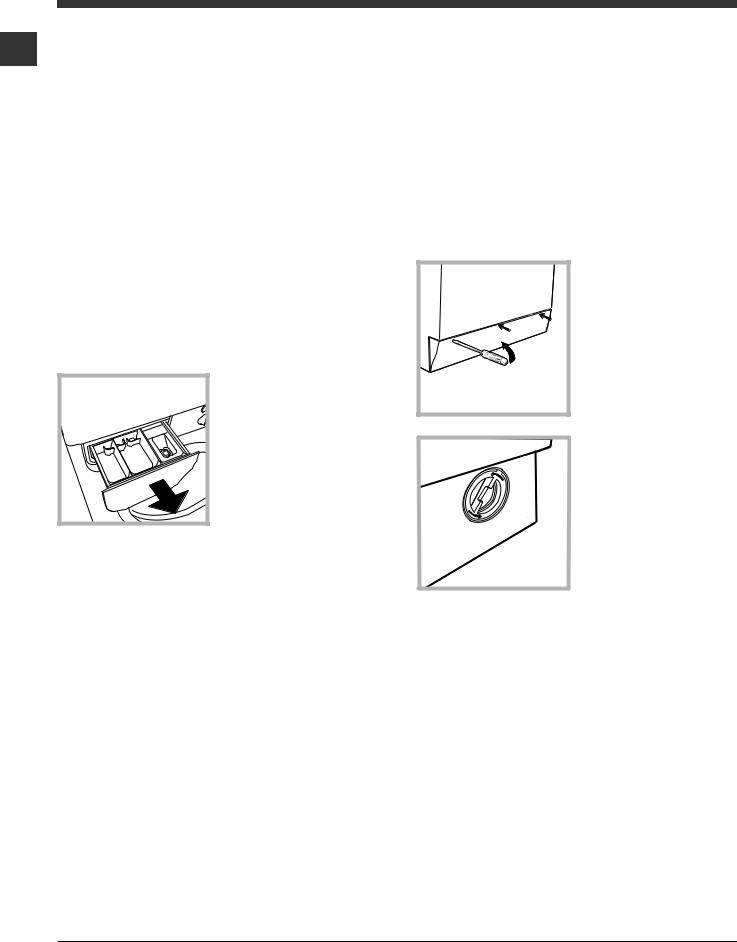
Care and maintenance
Cutting off the water and electricity GB supplies
•Turn off the water tap after every wash cycle. This will limit wear on the hydraulic system inside the washing machine and help to prevent leaks.
•Unplug the washing machine when cleaning it and during all maintenance work.
Cleaning the pump
The washing machine is fitted with a self-cleaning pump which does not require any maintenance. Sometimes, small items (such as coins or buttons) may fall into the prechamber which protects the pump, situated in its bottom part.
! Make sure the wash cycle has finished and unplug the appliance.
Cleaning the washing machine
The outer parts and rubber components of the appliance can be cleaned using a soft cloth soaked in lukewarm soapy water. Do not use solvents or abrasives.
Cleaning the detergent dispenser drawer
Remove the dispenser by raising it and pulling it out (see figure).
Wash it under running water; this operation should be repeated frequently.
Caring for the door and drum of your appliance
•Always leave the porthole door ajar in order to prevent unpleasant odours from forming.
To access the pre-chamber:
1. using a screwdriver, remove the cover panel on the lower front part of the washing machine (see figure);
2. unscrew the lid by rotating it anti-clockwise (see figure): a little water may trickle out. This is perfectly normal;
3.clean the inside thoroughly;
4.screw the lid back on;
5.reposition the panel, making sure the hooks are securely in place before you push it onto the appliance.
Checking the water inlet hose
Check the inlet hose at least once a year. If there are any cracks, it should be replaced immediately: during the wash cycles, water pressure is very strong and a cracked hose could easily split open.
! Never use second-hand hoses.
10

Troubleshooting
|
|
|
|
|
Your washing machine could fail to work. Before contacting the Technical Assistance Centre (see “Assistance”), make sure |
|
|||
GB |
||||
that the problem cannot be not solved easily using the following list. |
||||
|
||||
Problem: |
Possible causes / Solutions: |
|
||
|
||||
The washing machine does not switch on.
The wash cycle does not start.
•The appliance is not plugged into the socket fully, or is not making contact.
•There is no power in the house.
•The washing machine door is not closed properly.
•The ON/OFF button has not been pressed.
•The START/PAUSE button has not been pressed.
•The water tap has not been opened.
•A delayed start has been set (see “Personalisation”).
The washing machine does not take in water (the indicator light for the first wash cycle stage flashes rapidly).
•The water inlet hose is not connected to the tap.
•The hose is bent.
•The water tap has not been opened.
•There is no water supply in the house.
•The pressure is too low.
•The START/PAUSE button has not been pressed.
The washing machine continuously • The drain hose is not fitted at a height between 65 and 100 cm from the floor takes in and drains water. (see “Installation”).
•The free end of the hose is under water (see “Installation”).
•The wall drainage system is not fitted with a breather pipe.
If the problem persists even after these checks, turn off the water tap, switch the appliance off and contact the Assistance Service. If the dwelling is on one of the upper floors of a building, there may be problems relating to water drainage, causing the washing machine to fill with water and drain continuously. Special anti-draining valves are available in shops and help to avoid this inconvenience.
The washing machine does not drain or spin.
•The wash cycle does not include draining: some wash cycles require the drain phase to be started manually.
•The drain hose is bent (see “Installation”).
•The drainage duct is clogged.
The washing machine vibrates a lot • The drum was not unlocked correctly during installation (see “Installation”). during the spin cycle. • The washing machine is not level (see “Installation”).
• The washing machine is trapped between cabinets and walls (see “Installation”).
The washing machine leaks. • The water inlet hose is not screwed on properly (see “Installation”).
•The detergent dispenser drawer is blocked (for cleaning instructions, see “Care and maintenance”).
•The drain hose is not fixed properly (see “Installation”).
The “Functions” indicator lights and the “start/pause” indicator light flash, while one of the “phase in progress” indicator lights and the “door locked” indicator light will remain lit in a fixed manner.
•Switch off the machine and unplug it, wait for approximately 1 minute and then switch it back on again.
If the problem persists, contact the Technical Assistance Service.
There is too much foam.
•The detergent is not suitable for machine washing (it should display the text “for washing machines” or “hand and machine wash”, or the like).
•Too much detergent was used.
11

Service
|
|
|
|
|
|
Before calling for Assistance: |
|
GB |
|||
|
• Check whether you can solve the problem alone (see “Troubleshooting”); |
||
|
|
• Restart the programme to check whether the problem has been solved; |
|
|
|||
|
|
• If this is not the case, contact an authorised Technical Assistance Centre using the telephone number provided on the |
|
|
|
guarantee certificate. |
|
|
|
! Always request the assistance of authorised technicians. |
Have the following information to hand:
•the type of problem;
•the appliance model (Mod.);
•the serial number (S/N).
This information can be found on the data plate applied to the rear of the washing machine, and can also be found on the front of the appliance by opening the door.
12

Návod k použití
CZ
Česky
IWSC 51051
Obsah
Instalace, 14-15
Rozbalení a vyrovnání do vodorovné polohy Připojení k elektrické a k vodovodní síti První prací cyklus
Technické údaje
PRAČKA
CZ
Popis pračky a zahájení pracího programu, 16-17
Ovládací panel Kontrolky
Zahájení pracího programu
Prací programy, 18
Tabulka pracích programů
Uživatelská nastavení, 19
Nastavení teploty
Nastavení rychlosti odstřeďování
Funkce
Prací prostředky a prádlo, 20
Dávkovač pracích prostředků
Cyklus bělení
Příprava prádla
Oděvy vyžadující zvláštní péči
Systém automatického vyvážení náplně
Opatření a rady, 21
Základní bezpečnostní pokyny
Likvidace
Údržba a péče, 22
Uzavření přívodu vody a vypnutí elektrického napájení Čištění pračky
Čištění dávkovače pracích prostředků Péče o dvířka a buben
Čištění čerpadla
Kontrola přítokové hadice na vodu
Poruchy a způsob jejich odstranění, 23 Servisní služba, 24
13
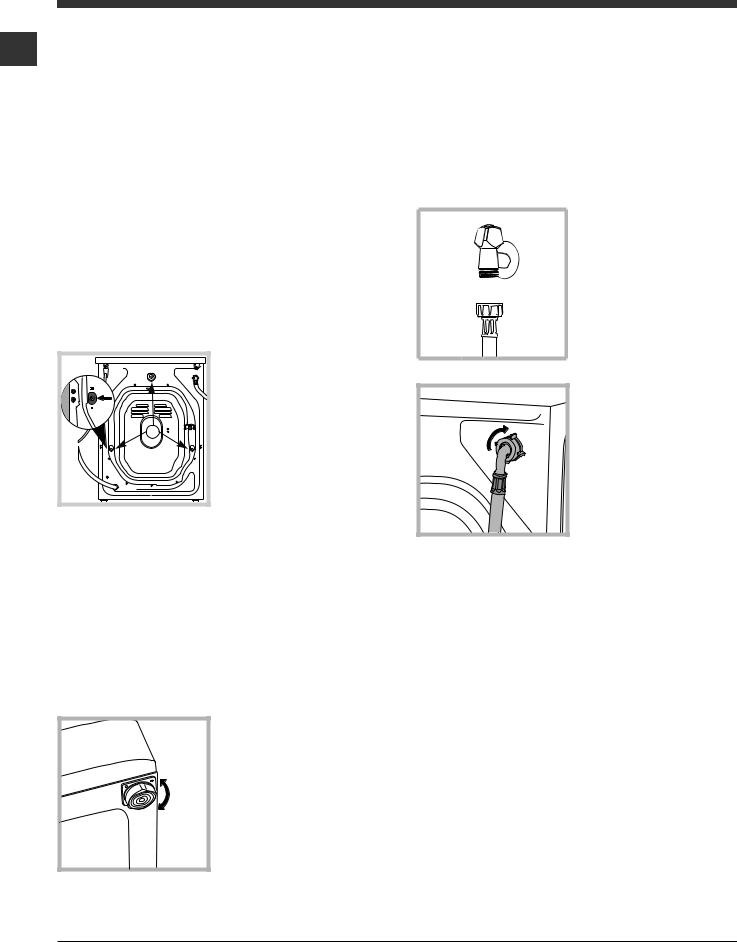
Instalace
! Je důležité uschovat tento návod tak, abyste jej mohli CZ kdykoli konzultovat. V případě prodeje, darování nebo
přestěhování pračky se ujistěte, že zůstane uložen
v blízkosti pračky, aby mohl posloužit novému majiteli při seznámení s její činností a s příslušnými upozorněními.
! Pozorně si přečtěte uvedené pokyny: obsahují důležité informace týkající se instalace, použití a bezpečnosti při práci.
Rozbalení a vyrovnání do vodorovné polohy
Rozbalení
1.Rozbalte pračku.
2.Zkontrolujte, zda během přepravy nedošlo k jejímu poškození. V případě, že je poškozena, ji nezapojujte a obraťte se na prodejce.
3. Odstraňte 3 šrouby chránící před poškozením během přepravy a gumovou podložku s příslušnou rozpěrkou, které se nacházejí v zadní části (viz obrázek).
4.Uzavřete otvory po šroubech plastovými krytkami z příslušenství.
5.Uschovejte všechny díly: v případě opětovné přepravy pračky je bude třeba namontovat zpět.
! Obaly nejsou hračky pro děti!
Vyrovnání do vodorovné polohy
1. Pračku je třeba umístit na rovnou a pevnou podlahu, aniž by se opírala o stěnu, nábytek či něco jiného.
2. V případě, že podlaha není dokonale vodorovná, mohou být případné rozdíly vykompenzovány šroubováním předních nožek (viz obrázek); Úhel sklonu, naměřený na pracovní ploše, nesmí přesáhnout 2°.
Dokonalé vyrovnání do vodorovné polohy zabezpečí stabilitu zařízení a zamezí vzniku vibrací a hluku během činnosti. V případě instalace na podlahovou krytinu nebo na koberec nastavte nožky tak, aby pod pračkou zůstal dostatečný volný prostor pro ventilaci.
Připojení k elektrické a k vodovodní síti
Připojení přítokové hadice vody
1. Připojte přívodní hadici jejím zašroubováním ke kohoutku studené vody s hrdlem se závitem 3/4“ (viz obrázek).
Před připojením hadice nechte vodu odtékat, dokud nebude čirá.
2. Připojte přítokovou hadici k pračce prostřednictvím příslušné přípojky na vodu, umístěné vpravo nahoře
(viz obrázek).
3. Dbejte na to, aby hadice nebyla příliš ohnutá ani stlačená.
!Tlak v rozvodu vody se musí pohybovat v rozmezí hodnot uvedených v tabulce s technickými údaji
(viz vedlejší strana).
!V případě, že délka přítokové hadice nebude dostatečná, obraťte se na specializovanou prodejnu nebo na autorizovaný technický personál.
!Nikdy nepoužívejte již použité hadice.
!Používejte hadice z příslušenství zařízení.
14

Připojení vypouštěcí hadice |
|
|
|
Připojte vypouštěcí hadi- |
|
|
ci, aniž byste ji ohýbali, |
|
|
k odpadovému potrubí |
|
|
nebo k odpadu ve stěně, |
|
65 - 100 cm |
který se nachází od 65 do |
|
100 cm nad zemí; |
||
|
||
|
nebo ji uchyťte k okra- |
|
|
ji umývadla či vany a |
|
|
připevněte vodicí držák |
|
|
z příslušenství ke kohoutu |
|
|
(viz obrázek). Volný konec |
|
|
vypouštěcí hadice nesmí |
|
|
zůstat ponořený do vody. |
! Použití prodlužovacích hadic se nedoporučuje; je-li však nezbytné, prodlužovací hadice musí mít stejný průměr jako originální hadice a její délka nesmí přesáhnout 150 cm.
Připojení k elektrické síti
Před zasunutím zástrčky do zásuvky se ujistěte, že:
•Je zásuvka uzemněna a že vyhovuje normám;
•je zásuvka schopna snést maximální zátěž odpovídající jmenovitému příkonu zařízení, uvedenému v tabulce s technickými údaji
(viz vedle);
•hodnota napájecího napětí odpovídá údajům uvedeným v tabulce s technickými údaji
(viz vedle);
•je zásuvka kompatibilní se zástrčkou pračky.
V opačném případě je třeba vyměnit zásuvku nebo zástrčku.
!Pračka nesmí být umístěna venku – pod širým nebem, a to ani v případě, že by se jednalo o místo chráněné před nepřízní počasí, protože je velmi nebezpečné vystavit ji působení deště a bouří.
!Po definitivní instalaci pračky musí zásuvka zůstat snadno přístupná.
! Nepoužívejte prodlužovací kabely a rozvodky.
CZ
!Kabel nesmí být ohnutý ani stlačený.
!Výměna kabelu musí být svěřena výhradně autorizovanému technickému personálu.
Upozornění! Výrobce neponese žádnou odpovědnost za následky nerespektování uvedených předpisů.
První prací cyklus
Po instalaci zařízení je třeba ještě předtím, než je použijete na praní prádla, provést jeden zkušební cyklus s pracím prostředkem a bez náplně prádla nastavením pracího programu 2.
Technické údaje
Model |
IWSC 51051 |
||||
|
|
|
|
|
|
Rozměry |
šířka |
59,5 cm |
|||
výška |
85 cm |
||||
|
|
|
hloubka 44 cm |
||
|
|
|
|
||
Kapacita |
od 1 do 5 kg |
||||
|
|
|
|
||
Napájení |
Viz štítek s technickými údaji, aplikovaný |
||||
na zařízení. |
|||||
|
|
|
|||
|
|
|
|
||
Připojení k |
maximální tlak 1 MPa (10 bar) |
||||
minimální tlak 0.05 MPa (0.5 bar) |
|||||
rozvodu vody |
|||||
kapacita bubnu 40 litrů |
|||||
|
|
|
|||
|
|
|
|
|
|
Rychlost |
až do 1000 otáček za minutu |
||||
odstřeďování |
|||||
|
|
||||
Kontrolní pro- |
program 2; standardní program pro bavlnu |
||||
gramy podle |
pro praní při 60°C. |
||||
směrnic 1061/2010 |
program 3; standardní program pro bavlnu |
||||
a 1015/2010 |
pro praní při 40°C. |
||||
|
|
|
Toto zařízení odpovídá následujícím nor- |
||
|
|
|
mám Evropské unie: |
||
|
|
|
- 2004/108/CE (Elektromagnetická kom- |
||
|
|
|
patibilita) |
||
|
|
|
- 2006/95/CE (Nízké napětí) |
||
|
|
|
- 2002/96/CE |
||
|
|
|
|||
|
|
|
|
|
|
Hlučnost |
Praní: 59 |
||||
(dB(A) re 1 pW) |
Odstřeďování: 77 |
||||
15
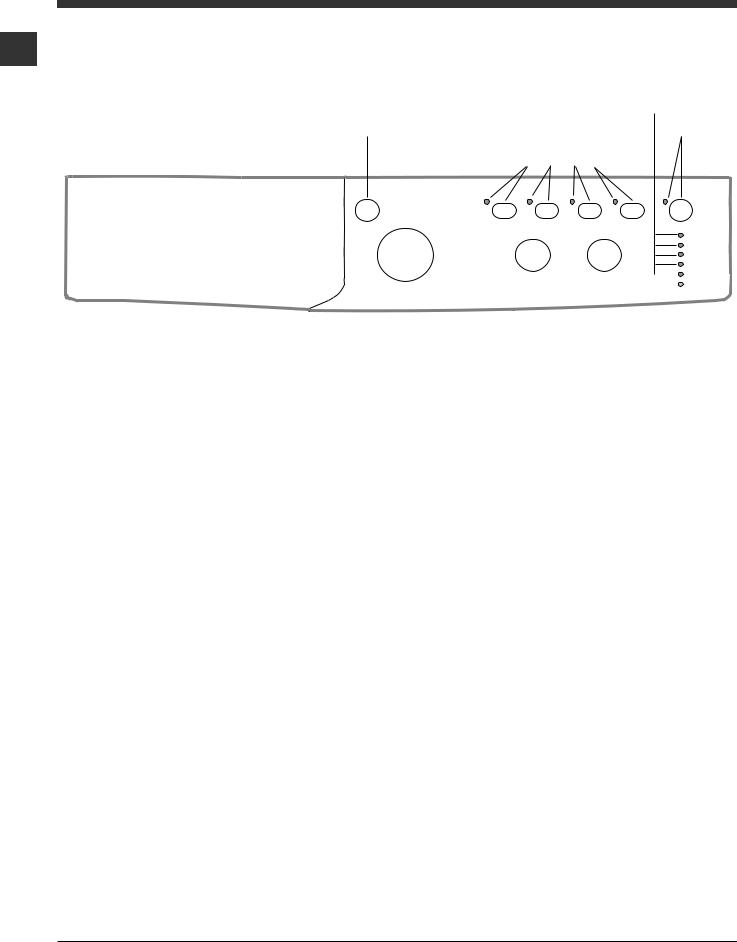
Popis pračky a zahájení pracího programu
Ovládací panel
CZ
|
Kontrolky PRŮBĚHU PRACÍHO |
||
|
CYKLU/ODLOŽENÉHO STARTU |
||
|
FUNKČNÍ |
Tlačítko s |
|
Tlačítko |
kontrolkou |
||
tlačítka s kontrolkami |
|||
ON/OFF |
START/ |
||
|
|||
|
|
PAUSE |
|
|
|
|
Otočný ovladač |
|
|
|
|
|
|
|
|
|
|
|
|
|
|
||
|
|
|
|
Kontrolka |
|||||
|
|
|
TEPLOTY |
|
|||||
Dávkovač pracích prostředků |
|
|
ZABLOKOVANÁ |
||||||
Otočný ovladač |
Otočný ovladač |
DVÍŘKA |
|||||||
|
|
||||||||
|
|
PROGRAMŮ |
ODSTŘEĎOVÁNÍ |
|
|
|
|
||
Dávkovač pracích prostředků: slouží k dávkování pracích prostředků a přídavných prostředků (viz „Prací prostředky a prádlo“).
Tlačítko ON/OFF: slouží k zapnutí a vypnutí pračky.
Otočný ovladač PROGRAMŮ: pro nastavení pracích programů. Během pracího programu zůstane ve stejné poloze.
FUNKČNÍ tlačítka s kontrolkami: slouží k volbě jednotlivých dostupných funkcí. Kontrolka zvolené funkce zůstane rozsvícena.
Otočný ovladač ODSTŘEĎOVÁNÍ: slouží k nastavení odstřeďování nebo k jeho vyloučení (viz „Uživatelská nastavení“).
Otočný ovladač TEPLOTY: slouží k nastavení teploty praní nebo praní ve studené vodě (viz „Uživatelská nastavení“).
Kontrolky PRŮBĚHU PRACÍHO CYKLU/ ODLOŽENÉHO STARTU: slouží ke kontrole průběhu pracího programu.
Rozsvícená kontrolka poukazuje na probíhající fázi. V případě, že byla nastavena funkce „Odloženého
startu“, budou informovat o čase zbývajícím do zahájení pracího programu (viz vedlejší strana).
Kontrolka ZABLOKOVANÁ DVÍŘKA: informuje o tom, zda je možné otevřít dvířka (viz vedlejší strana).
Tlačítko s kontrolkou START/PAUSE: Slouží ke spuštění nebo dočasnému přerušení programů.
POZN.: Stisknutí tohoto tlačítka slouží k přerušení probíhajícího praní; příslušná kontrolka bude blikat oranžovým světlem, zatímco kontrolka probíhající fáze zůstane rozsvícena stálým světlem. Když bude kontrolka ZABLOKOVANÁ DVÍŘKA  zhasnuta, bude možné otevřít dvířka.
zhasnuta, bude možné otevřít dvířka.
Za účelem opětovného zahájení praní z bodu, ve kterém bylo přerušeno, znovu stiskněte toto tlačítko.
Pohotovostní režim
Za účelem shody s novými předpisy souvisejícími s energetickou úsporou je tato pračka vybavena systémem automatického vypnutí (přechodu do pohotovostního režimu – standby), který je aktivován po uplynutí několika minut, když se pračka nepoužívá. Krátce stiskněte tlačítko ON-OFF (ZAPNOUT-VYPNOUT) a vyčkejte na obnovení činnosti zařízení.
Spotřeba v off-mode: 1W
Spotřeba v Left-on: 1W
16
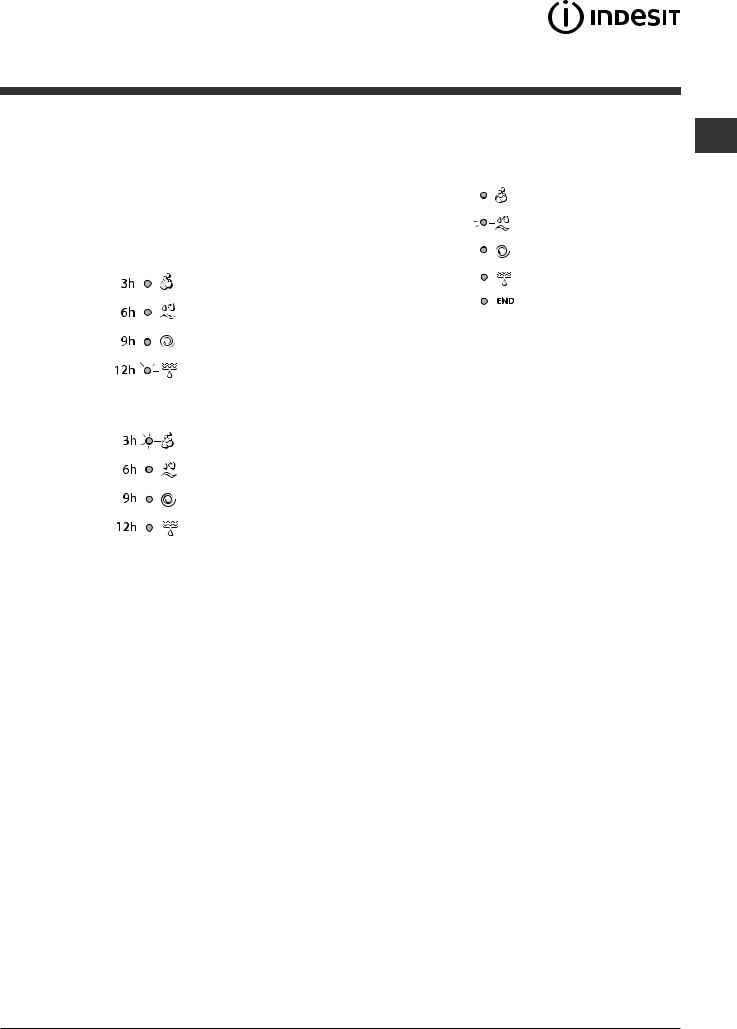
Kontrolky
Kontrolky jsou zdrojem důležitých informací. Informují nás o následujících skutečnostech:
Odložený start
Když byla aktivována funkce „Odloženého startu“ (viz „Uživatelská nastavení“), po zahájení pracího programu začne blikat příslušná kontrolka zvoleného odložení:
Průběžně bude zobrazován čas zbývající do startu a zobrazování bude provázeno blikáním příslušné kontrolky:
Po uplynutí zvolené doby odložení dojde k zahájení nastaveného programu.
Kontrolka aktuální fáze pracího programu:
Po zvolení a zahájení požadovaného pracího cyklu dojde |
CZ |
k postupnému rozsvícení kontrolek informujících o jeho |
|
průběhu. |
|
Praní |
|
Máchání
Odstřeďování
Odčerpání vody
Ukončení praní
Funkční tlačítka a příslušné kontrolky
Po zvolení konkrétní funkce dojde k rozsvícení příslušné kontrolky.
V případě, že zvolená funkce není kompatibilní s nastaveným pracím programem, příslušná kontrolka začne blikat a funkce nebude aktivována.
V případě, že zvolená funkce není kompatibilní s jinou předem zvolenou funkcí, kontrolka první funkce bude blikat a bude aktivována pouze druhá, přičemž kontrolka zvolené funkce se rozsvítí stálým světlem.
 Kontrolka zablokovaných dvířek
Kontrolka zablokovaných dvířek
Rozsvícení této kontrolky poukazuje na to, že dvířka jsou zajištěna kvůli zamezení náhodnému otevření; aby se zabránilo poškození dvířek, před jejich otevřením je třeba vyčkat, dokud uvedená kontrolka nezhasne; (vyčkejte přibližně 3 minuty). Za účelem otevření dvířek v průběhu pracího cyklu stiskněte tlačítko START/PAUSE; když bude kontrolka ZABLOKOVANÁ DVÍŘKA zhasnutá, bude možné otevřít dvířka.
Zahájení pracího programu
1.Zapněte pračku stisknutím tlačítka ON/OFF. Všechny kontrolky se rozsvítí na několik sekund, poté se zhasnou a bude blikat kontrolka START/PAUSE.
2.Naplňte pračku a zavřete dvířka.
3.Otočným ovladačem PROGRAMŮ nastavte požadovaný prací program.
4.Nastavte teplotu praní (viz „Uživatelská nastavení“).
5.Nastavte rychlost odstřeďování (viz „Uživatelská nastavení“).
6.Nadávkujte prací prostředek a přídavné prostředky (viz „Prací prostředky a prádlo“).
7.Zvolte požadované funkce.
8.Zahajte prací program stisknutím tlačítka START/PAUSE a příslušná kontrolka zůstane rozsvícena stálým světlem zelené barvy. Zrušení nastaveného pracího cyklu se provádí přerušením činnosti zařízení stisknutím tlačítka START/PAUSE a volbou nového cyklu.
9.Po ukončení pracího programu se rozsvítí kontrolka
 . Po zhasnutí kontrolky ZABLOKOVANÁ DVÍŘKA
. Po zhasnutí kontrolky ZABLOKOVANÁ DVÍŘKA  bude možné otevřít dvířka. Vytáhněte prádlo a nechte dvířka pootevřená, aby bylo umožněno vysušení bubnu. Vypněte pračku stisknutím tlačítka ON/OFF.
bude možné otevřít dvířka. Vytáhněte prádlo a nechte dvířka pootevřená, aby bylo umožněno vysušení bubnu. Vypněte pračku stisknutím tlačítka ON/OFF.
17
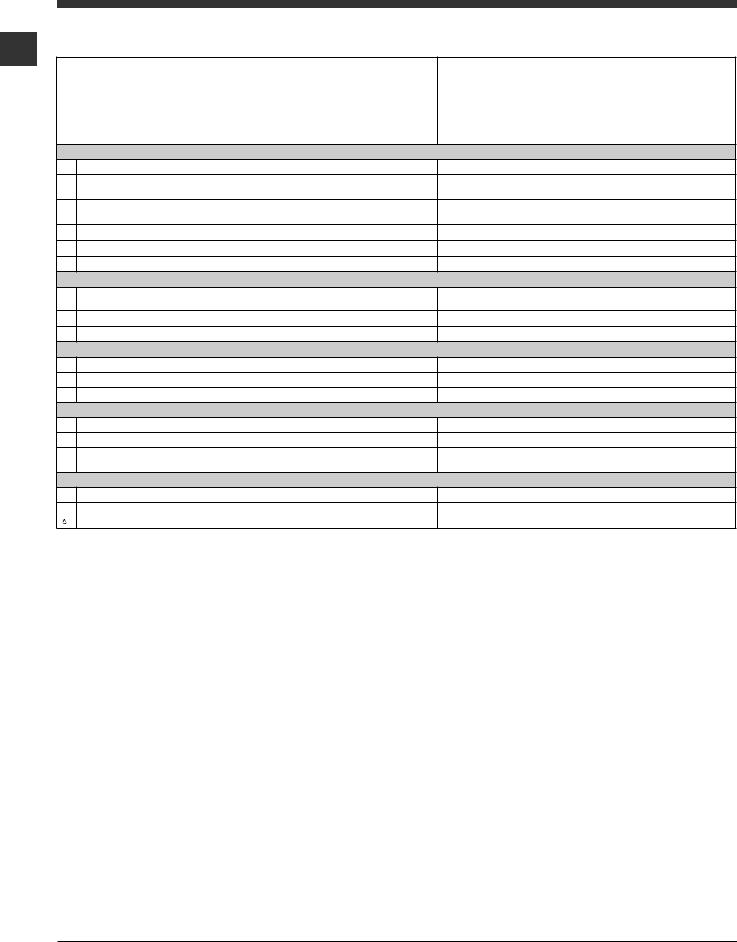
Prací programy
Tabulka pracích programů
CZ
Programy |
Popis programu |
|
|
|
|
Programy pro kazdodenní praní (Daily)
1 Bavlna + pøedpraní: mimoøádnì zneèištìné bílé prádlo.
2Standardní program pro bavlnu pro praní při 60°C (1): silnì zneèištìné bílé a barevné prádlo z odolných tkanin.
3Standardní program pro bavlnu pro praní při 40°C (2): silnì zneèištìné bílé a barevné choulostivé prádlo.
4Syntetika:velmizneèištìnébarevnéprádlozodolnýchtkanin.
4Syntetika(3):èásteènézneèištìnébarevnéprádlozodolnýchtkanin. 5 Barevná bavlna: málo zneèištìné bílé a barevné choulostivé prádlo.
20° Zone
6Standardníprogramprobavlnupropranípři20°C: silnìzneèištìnébíléabarevné choulostivéprádlo.
7 Mix Light
8 20’ Refresh
Speciální programy (Special)
9 HEDVÁBÍ/ZÁCLONY: pro prádlo z hedvábí, viskózy, spodní prádlo.
10 Vlna: pro vlnu, kašmír atd.
11 Jeans
Sport
12 Sport Intensive
13 Sport Light
14 Sport Shoes
Dílèí programy
 Máchání
Máchání
 Odstøeïování + Odèerpání vody
Odstøeïování + Odèerpání vody
|
rychlostMax. minutu)za(otáèky |
Pøedpraní |
|
Praní |
|
Aviváz |
|
Bìlicí prostøedek |
(kg)náplòMax. |
Zbytková %vlhkost |
Spotøeba kWhenergie |
Celkové ltvodymnoství |
durationCycle |
|
|
Prací prostøedky |
|
|
|
|
|
||||||
Max. |
|
|
|
|
|
|
|
|
|
|
|
|
|
|
|
|
|
|
|
|
|
|
|
|
|
|
|
teplota |
|
|
|
|
|
|
|
|
|
|
|
|
|
(°C) |
|
|
|
|
|
|
|
|
|
|
|
|
|
90° |
|
|
|
|
|
|
|
|
|
|
|
|
145’ |
|
|
|
|
|
|
|
|
||||||
1000 |
|
|
|
- |
5 |
62 |
1,68 |
61 |
|||||
60° |
1000 |
- |
|
|
|
|
|
|
5 |
62 |
0,89 |
45 |
175’ |
(Max.90°) |
|
|
|
||||||||||
40° |
1000 |
- |
|
|
|
|
|
|
5 |
62 |
0,75 |
60 |
165’ |
60° |
800 |
- |
|
|
|
|
|
|
2,5 |
44 |
0,70 |
40 |
100’ |
40° |
800 |
- |
|
|
|
|
|
|
2,5 |
44 |
0,47 |
38 |
90’ |
40° |
1000 |
- |
|
|
|
|
|
|
5 |
62 |
0,59 |
48 |
80’ |
20° |
|
|
|
|
|
|
|
|
|
|
|
|
170’ |
1000 |
- |
|
|
|
5 |
- |
- |
- |
|||||
20° |
800 |
- |
|
|
|
|
|
|
5 |
- |
- |
- |
120’ |
20° |
800 |
- |
|
|
|
|
|
- |
1,5 |
- |
- |
- |
20’ |
30° |
|
|
|
|
|
|
|
|
|
|
|
55’ |
|
0 |
- |
|
|
|
- |
1 |
- |
- |
- |
||||
40° |
800 |
- |
|
|
|
|
|
- |
1 |
- |
- |
- |
55’ |
40° |
800 |
- |
|
|
|
|
|
- |
2,5 |
- |
- |
- |
70’ |
30° |
|
|
|
|
|
|
|
|
|
|
|
85’ |
|
600 |
- |
|
|
|
- |
2,5 |
- |
- |
- |
||||
30° |
600 |
- |
|
|
|
|
|
- |
2,5 |
- |
- |
- |
60’ |
30° |
600 |
- |
|
|
|
|
|
- |
Max. |
- |
- |
- |
55’ |
|
|
|
|
|
|
|
|
|
2 páry. |
|
|
|
|
- |
|
|
|
|
|
|
|
|
|
|
|
36’ |
|
1000 |
- |
|
- |
|
|
5 |
- |
- |
- |
||||
- |
1000 |
- |
|
- |
|
- |
|
- |
5 |
- |
- |
- |
16’ |
|
|
|
|
|
|
|
|
|
|
|
|
|
|
Doba trvání cyklu uvedená na displeji nebo v návodu představuje odhad vypočítaný na základě standardních podmínek. Skutečná doba se může měnit v závislosti na četných faktorech, jako je např. teplota a tlak vody na vstupu, teplota prostředí, množství pracího prostředku, množství a druh náplně, vyvážení náplně a zvolené volitelné funkce.
1) Kontrolní program podle normy 1061/2010: nastavte program 2 s teplotou 60°C.
Tento cyklus je vhodný pro praní běžně znečištěné bavlny a jedná se o nejúčinnější cyklus z hlediska kombinované spotřeby energie a vody určený pro prádlo, které lze prát při teplotě do 60 °C. Skutečná teplota praní se může lišit od uvedené.
2) Kontrolní program podle normy 1061/2010: nastavte program 3 s teplotou 40°C.
Tento cyklus je vhodný pro praní běžně znečištěné bavlny a jedná se o nejúčinnější cyklus z hlediska kombinované spotřeby energie a vody určený pro prádlo, které lze prát při teplotě do 40°C. Skutečná teplota praní se může lišit od uvedené.
Pro všechny Kontrolní ústavy:
2) Dlouhý program na praní bavlny: nastavte program 3 s teplotou 40°C. 3) Syntetický program spolu: nastavte program 4 s teplotou 40°C.
Sport Intensive (program 12) byl navržen pro velmi znečištěné látky sportovního oblečení (teplákové soupravy, šortky apod.); pro dosažení optimálních výsledků se doporučuje nepřekračovat maximální náplň uvedenou v “Tabulka pracích programů”. Sport Light (program 13) byl navržen pro mírně znečištěné látky sportovního oblečení (teplákové soupravy, šortky apod.); pro dosažení optimálních výsledků se doporučuje nepřekračovat maximální náplň uvedenou v “Tabulka pracích programů”. Doporučuje se použít tekutý prací prostředek a použít dávku vhodnou pro poloviční náplň.
Sport Shoes (program 14) byl navržen pro praní sportovní obuvi; pro dosažení optimálních výsledků neperte více než 2 páry najednou.
Programy 20° (20° Zone) nabízejí dobrou výkonnost praní při nízkých teplotách, přičemž umožňují nižší použití elektrické energie s výhodami pro finanční úsporu i pro životní prostředí. Programy 20° vyhovují všem požadavkům:
Standardní program pro bavlnu pro praní při 20°C (program 6) ideální pro náplně ze znečištěné bavlny. Dobrá výkonnost i za studena, srovnatelná s praním při 40 °C, je zaručena mechanickým působením, které je založeno na změně rychlosti v krátkých nebo dlouhých intervalech.
Mix Light (program 7)ideální pro smíšené náplně (bavlna a syntetika), tvořené středně znečištěným prádlem. Dobrá výkonnost praní i za studena je zaručena mechanickým působením, které je založeno na změně rychlosti ve středních nebo určených intervalech.
20’ Refresh (program 8) osvěžení ideální cyklus pro osvěžení a praní mírně znečištěného prádla v průběhu pár minut. Trvá pouze 20 minut a šetří tak čas i energii. Umožňuje prát dohromady tkaniny různého druhu (s výjimkou vlny a hedvábí) při náplni nepřesahující 1,5 kg.
18
